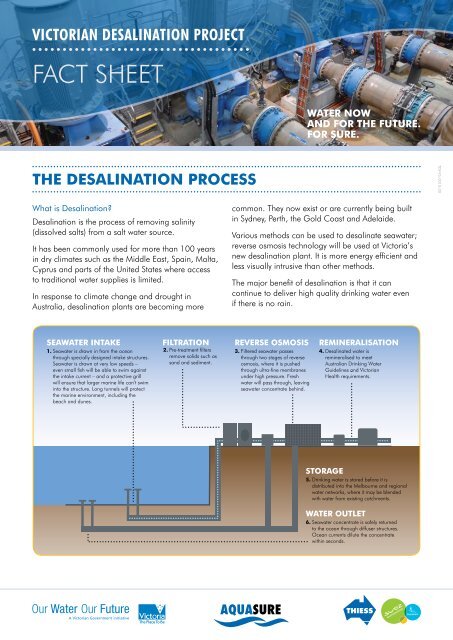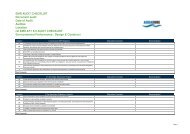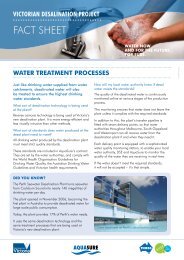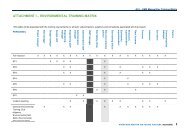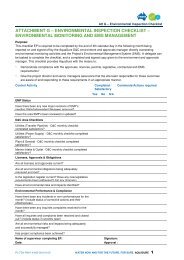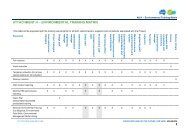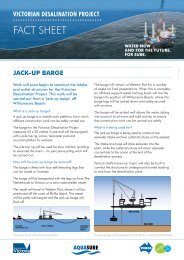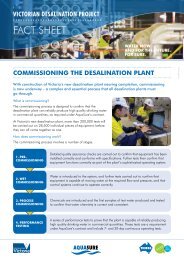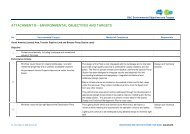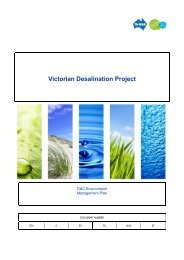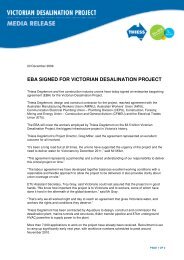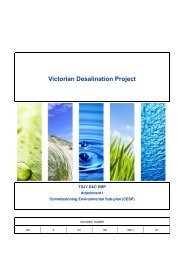Desalination Process fact sheet - Aquasure
Desalination Process fact sheet - Aquasure
Desalination Process fact sheet - Aquasure
Create successful ePaper yourself
Turn your PDF publications into a flip-book with our unique Google optimized e-Paper software.
VICTORIAN DESALINATION PROJECT<br />
FACT SHEET<br />
The <strong>Desalination</strong> <strong>Process</strong><br />
TDV-FS-0010-00<br />
What is <strong>Desalination</strong><br />
<strong>Desalination</strong> is the process of removing salinity<br />
(dissolved salts) from a salt water source.<br />
It has been commonly used for more than 100 years<br />
in dry climates such as the Middle East, Spain, Malta,<br />
Cyprus and parts of the United States where access<br />
to traditional water supplies is limited.<br />
In response to climate change and drought in<br />
Australia, desalination plants are becoming more<br />
common. They now exist or are currently being built<br />
in Sydney, Perth, the Gold Coast and Adelaide.<br />
Various methods can be used to desalinate seawater;<br />
reverse osmosis technology will be used at Victoria’s<br />
new desalination plant. It is more energy efficient and<br />
less visually intrusive than other methods.<br />
The major benefit of desalination is that it can<br />
continue to deliver high quality drinking water even<br />
if there is no rain.
Why is it called Reverse Osmosis<br />
Osmosis is the process where water molecules move<br />
across a semi permeable membrane from an area<br />
of lower salt concentration to an area of higher<br />
concentration. The process does not use any energy.<br />
An example of this in nature is the movement of<br />
water from the soil into plant roots. It is also how<br />
flowers take in water when they are in a vase.<br />
Reverse Osmosis membranes<br />
Each reverse osmosis membrane has a surface<br />
area of 40.9 square metres. The membrane<br />
material is wrapped rather like a closed umbrella<br />
inside each cylinder.<br />
Reverse osmosis is the opposite process. Energy is<br />
used to apply pressure to water to force it to move<br />
from an area of higher salt concentration (in<br />
seawater) to an area of lower salt concentration.<br />
Salt Molecules<br />
Water Molecules<br />
High Pressure<br />
Reverse Osmosis Membrane<br />
contains very small pores which only<br />
let water molecules through. Just under<br />
half the water is collected in this way<br />
as fresh water, and the salt molecules<br />
which are too large are returned to<br />
the sea with the rest of the water.<br />
Seawater Intake<br />
Pre-treatment<br />
processes<br />
Post-treatment to<br />
meet Australian<br />
Drinking Water<br />
Guidelines<br />
To Melbourne and<br />
regional water networks<br />
Reverse Osmosis process<br />
Seawater Concentrate Outlet<br />
Simple outline of Reverse Osmosis <strong>Process</strong>
Reverse Osmosis <strong>Process</strong>ing Plant<br />
This is a plan view of the layout of the reverse osmosis processing plant. Water moves<br />
through the process from left to right. It takes about one hour for a water drop to move through<br />
from the seawater lift pump station (1) through the plant to the treated water storage (11).<br />
1 SEAWATER LIFT PUMP STATION<br />
Transfers seawater to the pump station via<br />
intake structures located on the seabed.<br />
2 SCREEN & FEED PUMP STATION<br />
Houses screen filters that remove large<br />
particles from seawater.<br />
3 PRETREATMENT DMPF<br />
Houses Dual Media Pressure Filters (DMPF)<br />
to remove fine particles from seawater.<br />
4 DMPF BACKWASH<br />
Collects backwash from the DMPFs and pumps<br />
it through to the Backwash Treatment Building.<br />
5 BACKWASH TREATMENT BUILDING<br />
Treats and stores backwash from the<br />
DMPF process before it is pumped to the<br />
Solids Treatment Building.<br />
6 REVERSE OSMOSIS BUILDING<br />
Water passes through two stages of<br />
reverse osmosis where minerals and salts<br />
are removed.<br />
7, 8 and 9 CHEMICAL BUILDINGS<br />
House chemicals like fluoride and<br />
carbon dioxide used to potabilise the<br />
desalinated water.<br />
10 LIME STORAGE AND SATURATION<br />
Houses lime used to remineralise the<br />
desalinated water.<br />
11 TREATED WATER STORAGE<br />
Stores potable water prior to distribution.<br />
12 SOLIDS TREATMENT BUILDING<br />
Settlement and centrifuge process used<br />
to dewater the backwash waste prior to<br />
transfer offsite.<br />
13 STABILISATION PONDS<br />
Treatment ponds used for the stabilisation<br />
and treatment of outfall waters.<br />
14 UTILITIES BUILDING<br />
15 and 16 ELECTRICAL ENCLOSUREs<br />
17 POTABILISATION SYSTEM<br />
Point for mixing of chemicals to produce<br />
safe drinking water.<br />
18 ADMINISTRATION COMPLEX<br />
Contains reception, offices, meeting rooms<br />
and plant control room.<br />
19 FIRE SERVICES BUILDING<br />
20 SUBSTATIONs<br />
Contain electrical equipment and transformers.<br />
21 TRANSFER PUMP STATION AND<br />
SURGE VESSELS<br />
Pumps potable water into the transfer pipeline.<br />
22 <strong>Process</strong> building<br />
Houses chemicals used to assist the reverse<br />
osmosis process.<br />
FUTURE PLANT EXPANSION<br />
ZONES TO 200GL
Reverse Osmosis building<br />
CONTACT US<br />
Visit the Victorian <strong>Desalination</strong> Project Community Information Centre<br />
Shop 2, 33– 35 Murray St, Wonthaggi<br />
Opening hours<br />
Tuesday – Friday 9.30am – 4.30pm, Saturday 9am – 12pm.<br />
July 2010<br />
Freecall<br />
1800 811 214<br />
Email<br />
contactus@aquasure.com.au<br />
Web<br />
www.aquasure.com.au<br />
Post<br />
AquaSure C/– PO Box 7387<br />
St Kilda Road, Melbourne<br />
VIC 8004<br />
Printed on Tudor RP, an Australian made paper that contains 100% recycled fibre. No chlorine bleaching occurs in the recycling process<br />
and Australian Paper is ISO 14001 certified. Sales of Tudor RP support Landcare Australia.


